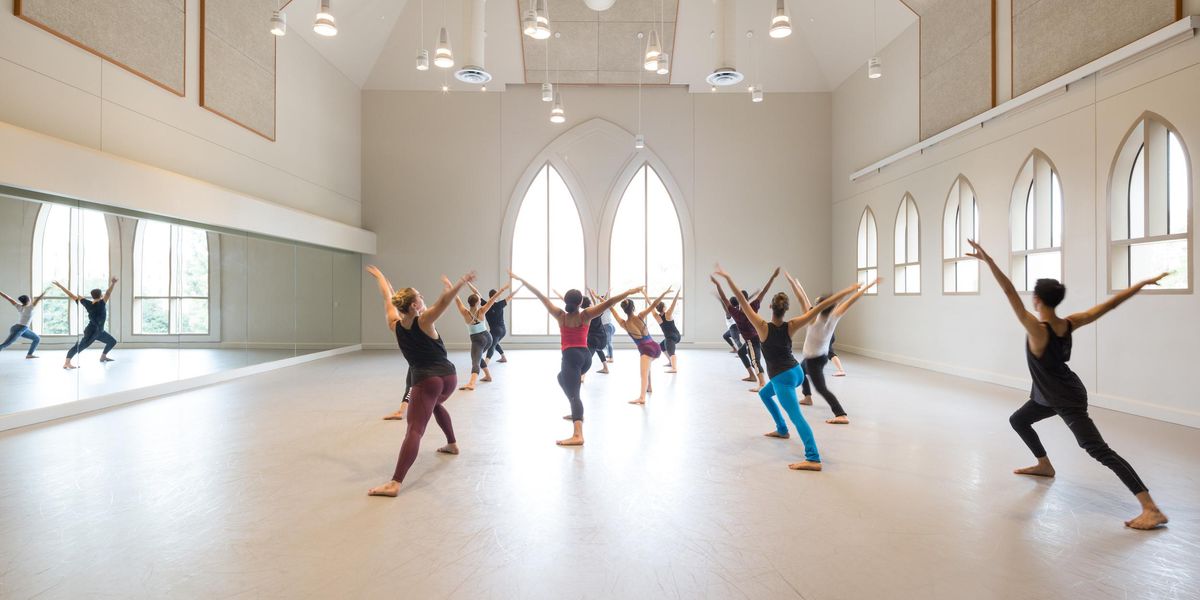Technique My Way: Toni Lugo
Strong and committed, onstage and off
Christopher Peddecord, Courtesy RDT
Toni Lugo, of Salt Lake City’s Repertory Dance Theatre, added to her dance bag of tricks last year by taking acting classes. In a recent rehearsal for RDT’s upcoming spring program, “Women of Valor,” Lugo demonstrated her newly mastered skill of delivering a monologue while dancing, which she had also honed through performing in local theater productions. The concert honors women who have served in the military, and through movement and spoken word, Lugo’s solo tells the story of the first woman to break the glass ceiling as an army mechanic. Lugo’s confident voice, sinewy muscle, and feminine features challenge all preconceived notions of mechanics as burly, macho guys.
Lugo’s signature style combines a sassy leap-before-you-look commitment (perhaps related to her childhood love of hockey and speed skating) with a knowledge of the American masters of modern dance. She is now in her sixth year with RDT, a company founded in 1966 as a repository of work by leading modern dance–makers. In adapting to a repertory that spans 100 years of stylistic changes, from José Limón to Yvonne Rainer to Zvi Gotheiner, “the body can be expected to take some pretty unpredictable twists and turns,” Lugo says. Fortunately, her early Graham and Limón training—at a performing arts high school in Orlando, Florida, and at the University of South Florida—make the contractions, swings, and falls familiar territory.
RDT’s schedule includes four season performances, out-of-state touring, and extensive educational programs in public schools. To keep up with the demands, Lugo has developed a strict regimen of nutrition, pre- and post-class warm-ups, and mental health practices.
Stretches in Bed
“When I was younger, I could just bust into class and start dancing,” Lugo laughs. “But after several seasons of dancing eight hours a day with the company, and being diagnosed as hypothyroid, I’m fanatical about self-care.”
Lugo’s routine begins before she gets out of bed in the morning and doesn’t end until she closes her eyes for eight hours of sleep a night, “because I do love my eight hours on the bed,” she says.
Lugo regards her body as a high-performance machine requiring special maintenance. “In the morning, before even getting out of bed and putting pressure on the feet and the ankle joints, I roll the ankles, stretch the feet by pressing through the metatarsals, and pull back through the heels for an Achilles stretch,” Lugo says. “I also yawn through all the joints and curl into a ball several times before getting out of bed.”
A hearty breakfast starts Lugo’s day before she layers on three sets of clothes and power-walks to the studio, four blocks away. “Throughout class I remove each layer as I warm up,” she says.
“I think the most important part of warming up is actually cooling down,” Lugo advises. “If you do a proper cool-down at the end of the day, your next morning warm-up is a lot easier. So I start and end rehearsal with gentle head and upper-spine rolls to generate the body’s natural heat.”
Extra Responsibility
Lugo’s rehearsal day ends at 4:00 p.m., but her job in RDT’s wardrobe department keeps her after hours, putting her extreme organizational skills to good use. (In a small company like RDT, dividing offstage responsibilities among the dancers helps to keep the operating budget down.) She knows every dancer’s entrances, exits, and quick changes, pre-setting their costumes in the wings to ensure that the show runs smoothly.
“There are seven different bodies with seven different shows in each performance, and I know every one of them,” Lugo says. “In our educational shows there can be as many as 23 costume changes, and I’m very particular that there are no tags hanging out, jewelry worn, or unshaven faces on the men.”
On tour, Lugo uses a self-designed checklist system to properly wash and rebox the 200 clothing items and props she is responsible for. “That’s why I have to take care of my own cool-down, because I don’t have the time after rehearsal or performance to be the dancer cooling down.”
Knowing yourself
Lugo believes one of the most important aspects of well-being for dancers (and all people) is mental health. She says she writes in her journal every day and sees a therapist regularly to stay at the top of her game.
“Artistry requires a lot of self-investigation, so it’s just smart to let a professional reframe negative or confusing thoughts that stop your forward progress,” Lugo says. “And my journal entries can be as simple as a budget I kept two years ago. But it reminds me of who I am, keeps me grounded, and organizes my thoughts.”
Kathy Adams writes on dance for the
Salt Lake Tribune.
Portable
Stress Relief
Lugo loves her Mukta Mat, an acupressure tool she takes on tour to reduce muscle soreness and relieve stress. (Imagine a yoga mat covered with thousands of tiny plastic spikes, or see www.huggermugger.com.) “One day a local guy walked into the studio selling these mats,” Lugo says, “and the whole company was like, ‘I want one of those!’ ”
• Begin or end your day lying on the mat, on your back, from mid-hip area to upper neck for 5 or 10 minutes, adjusting your weight as necessary. Cover the mat with a pillowcase until your body acclimates to the intensity of the pressure points.
• Follow your own breathing pattern to adapt to the surface and allow the blood to circulate. “It helps me get rid of all those checklists in my head,” Lugo says.
• As your body adjusts to the pressure points, add more time, moving the mat to places where your body feels most fatigued. Stand on it for a foot massage.
Lugo endorses the mat over more expensive massages or trips to the acupuncturist. “For $45, you’re in control of your own stress and pain relief.”




